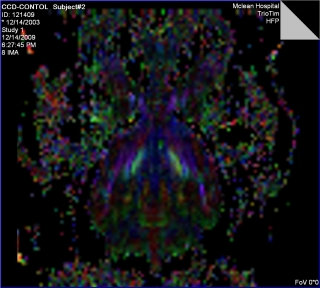“Inside a dog’s brain it’s too dark to read” … no more.

I hate to go on about our flank/blanket sucking Doberman study (not really) but it’s getting really fascinating and taking us to new heights in terms of studying behavior, so I thought I would share.
Most of us are involved in dealing with a behavior we see on the outside – the so-called phenotype. Training involves modifying phenotypic expression. In science, we are taught to report what we actually see … and no more. It is taboo to interpret what goes on within. “After all,” they say, “a dog’s thoughts and emotions (if indeed they exist) are inaccessible and best left out of the picture.” Not so much these days, I would say.
As well as the phenotype, we now have the genotype (genetic makeup) and endophenotype (what goes on within). Of course, they always existed but now we can study them. Here’s an example that might help explain what I am going on about. London taxi drivers have to learn route maps of London with all the one-way streets before they can drive a cab. It takes 2 years to accumulate what is known as “the knowledge.” If you scan a taxi driver’s brain (by MRI) at this time, a memory center, the hippocampus, is considerably increased in size. When the taxi driver retires and no longer uses “the knowledge,” his hippocampus shrinks to normal size. In the first instance you can almost “see” the stored information (or rather, the effect it produces) and in the second you can see it fade way. So that brain structure, like all brain structures, is labile, plastic, and responding to use almost like a muscle. You know what they say about muscles in body building, “If you don’t use it you lose it.” So it is with the brain.
So, alterations in brain size and structure can be used to identify what’s going on. This is part of the endophenotype; in the case of dogs, the dog within. Well, looking at the brain structure of dogs with behavior problems is one of the things we are beginning to do and for the time being our compulsive Dobermans take center stage.
The studies are ongoing at Harvard’s famous McLean psychiatric hospital. We go down there to the MRI imaging center every 2 weeks to scan a dog. And this isn’t just any old scan but one-of-a-kind. The scanner uses one of the most powerful magnets around and generates crystal clear black and white images of the dog’s brain. But the sophisticated software allows us to do so much more. We can take small sections of the brain images and convert them into 3D images, which we can then rotate on the viewer to look at them (and measure) every which way. The 3D images appear like a block of Swiss cheese with apparent tracks running thorough them. Then we can tell the computer to color code nerve tracts, with the direction the fibers are running coded red, blue and green. We can even “remove” the brain from the field of view and leave the nerve tracts alone and they can be rotated and examined at will.
I’m telling you, some of these images look like modern art. So colorful, so meaningful, so original. We can also look at neurotransmitters in graphic form in regions we chose to study. This is what I call the cutting edge of brain research (in dogs, at least) and we are hopeful that it will shed light on not only underlying changes in obsessive-compulsive disorder but also, in future, on other behavioral conditions like aggression, hyperactivity and phobias. It may even be possible to assess training efficacy by seeing how large the hippocampus becomes after a few weeks of the right type of training or how severely affected fear centers are when punitive training is employed (there is already evidence that even mild/unpleasant electric shock has long lasting (like forever) detrimental effects on these centers in rodents .
Anyway, the frontiers are, well, in front of us and the possibilities seem boundless. On the other hand, Einstein said “(Only) two things are infinite: the universe and human stupidity; and I'm not so sure about the universe" so I had better curb my boundless enthusiasm.




